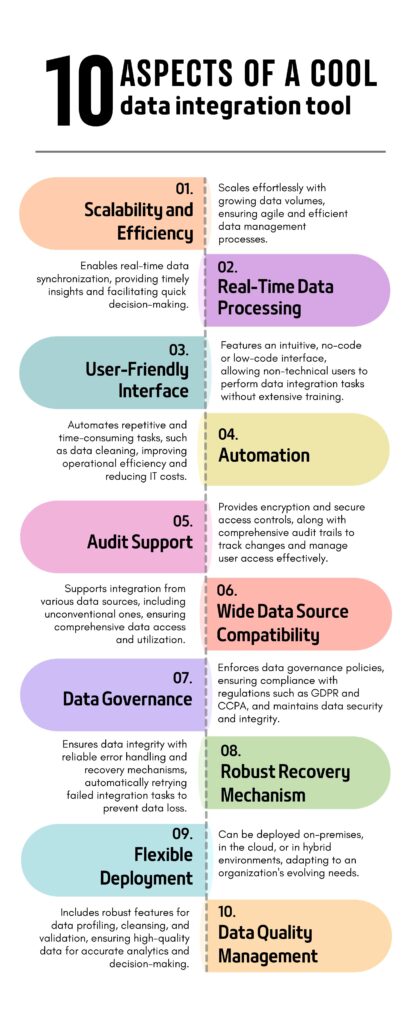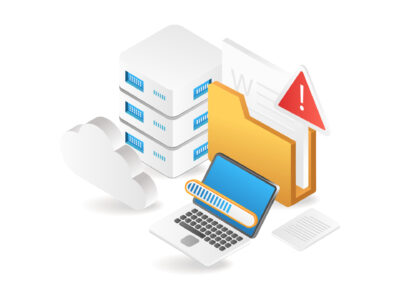Data integration tools are essential for modern enterprises to unify data from various sources, ensuring consistency, accessibility and accuracy. This is essential to meet the data consumption needs of business applications and end users. Data integration tools empower organizations to access, integrate, transform, process, and move data across various endpoints and infrastructures, supporting diverse integration use cases. Common challenges in data integration include dealing with different data formats, data quality issues, and ensuring data consistency across sources. The ETL (Extract, Transform, Load) process is fundamental in data integration, where data is extracted from various sources, transformed into a suitable format, and loaded into a data warehouse or other systems. Real-time data integration processes data as soon as it is created or modified, enabling up-to-date analytics and decision-making. In contrast, batch processing integrates data at scheduled intervals, which is less resource-intensive but provides less timely data.
With the rise of cloud computing, data integration tools now commonly support cloud-based sources and destinations, offering scalability and flexibility. Integrating big data involves handling large volumes of structured and unstructured data from sources such as social media, sensors, and logs. Data virtualization, meanwhile, allows users to access and query data without requiring it to be physically moved or transformed, offering real-time data access from multiple sources. APIs facilitate the integration of data between different systems and applications in real-time. Data lakes store vast amounts of raw data in its native format until needed, facilitating the integration and analysis of big data. Traditional data warehouses store integrated data from various sources, optimized for query and analysis. Hybrid integration combines on-premises and cloud-based solutions to provide flexibility and meet diverse business needs. It must be noted that data integration must comply with regulations such as GDPR, HIPAA, and CCPA to ensure data privacy and security.
Why Use Data Integration ?
1. Scalability for the Data Deluge
- Challenge: As data volumes surge, handling them manually becomes untenable.
- Solution: Data integration tools scale effortlessly, accommodating growth without breaking a sweat.
- Benefit: Organizations stay agile, ready to embrace expanding datasets.
2. AI and ML: For Automated Excellence
- Challenge: Extracting insights from raw data demands more than human effort.
- Solution: AI and ML algorithms—embedded in integration tools—automate transformations.
- Benefit: Data quality improves, and predictive models thrive.
3. Real-Time Insights: The Pulse of Decision-Making
- Challenge: Timely decisions require real-time data synchronization.
- Solution: Data integration tools keep systems in harmony, even as data dances across endpoints.
- Benefit: Business leaders make informed choices without missing a beat.
4. Cloud Integration: Elevating Data to New Heights
- Challenge: Balancing on-premises and cloud data silos.
- Solution: Cloud data integration bridges the gap, leveraging existing infrastructure.
- Benefit: Businesses soar on the cloud’s wings while preserving legacy investments.
5. Data Migration: A Seamless Transition
- Challenge: Moving data from old to new systems—without hiccups.
- Solution: Data integration tools orchestrate the migration ballet.
- Benefit: Data integrity remains intact, minimizing downtime during the transition.
6. Data Warehousing: Fueling Analytics Engines
- Challenge: Populating data warehouses with relevant, up-to-date data.
- Solution: Integration tools ensure warehouses hum with actionable insights.
- Benefit: Advanced analytics and data mining thrive, driving growth.
7. Data Governance: The Sentinel of Integrity
- Challenge: Navigating data compliance and security.
- Solution: Data integration tools enforce policies, guarding against missteps.
- Benefit: Organizations maintain trust, even in the most intricate data symphony.
Data integration isn’t just about moving bits—it’s about orchestrating a harmonious data ensemble. The question now is how to select the right tool for your organization. Continue reading to discover the top 15 data integration tools available today, each offering unique features and benefits to meet various business needs. But before that its important to know which factors should be considered to choose the best tool.
How to Pick the Right Data Integration Tool?
The market for data integration tools includes vendors offering standalone software products that facilitate the implementation of data access and delivery infrastructure for numerous data integration scenarios. Selecting the right tool requires a thorough understanding of your organization’s needs as well as the capabilities of the tool. Here are the key considerations to keep in mind:
Problem Definition and Requirements
- Identify the Problem: Start by pinpointing the specific data integration challenges your organization faces. This could range from consolidating data from disparate sources to enabling real-time data flow for analytics and reporting. Clearly defining the problem helps in selecting a tool that addresses your unique needs.
- User Requirements: Determine who will be using the data integration tool. Will it be limited to the data team, or will other departments require access? This decision impacts the number of licenses needed and the tool’s ease of use. A tool that is user-friendly for non-technical staff may be prioritized over one optimized for technical users.
Connectivity and Compatibility
- Data Source Connectivity: Ensure that the tool can connect to all required data sources. This includes pre-built connectors for databases, cloud services, APIs, and other platforms. Tools that offer regularly updated API connectors provide greater flexibility and reliability.
- Tool Compatibility: Assess the tool’s compatibility with your existing data infrastructure and technology stack. A tool that integrates seamlessly with your current systems is preferable to one that requires significant modifications or replacements.
Capability and Performance
- Integration Capabilities: Evaluate the tool’s ability to handle various data integration scenarios, such as batch processing, real-time streaming, and ETL processes. Ensure it supports the granularity and frequency of data fetching required for your operations.
- Performance Metrics: Consider the tool’s performance in terms of data processing speed, scalability, and efficiency. Tools that can handle large volumes of data with minimal latency are crucial for real-time applications.
Data Quality and Governance
- Data Quality Management: A robust data integration tool should include features for data profiling, cleansing, and quality management. Ensuring high data quality is essential for accurate analytics and decision-making.
- Governance Features: Look for tools that support data governance practices, including data lineage tracking, metadata management, and security controls. These features help maintain data integrity and comply with regulatory requirements.
Scalability and Future-Proofing
- Scalability: Choose a tool that can grow with your business. Consider future data volumes and integration needs to avoid outgrowing the tool’s capabilities. Tools that offer scalable solutions, such as cloud-based services, are often more adaptable.
- Future Developments: Investigate the vendor’s roadmap and future development plans for the tool. This helps ensure that the tool will continue to meet your evolving needs and leverage advancements in data integration technology.
Implementation and Support
- Implementation Ease: Assess the complexity of implementing the tool. Tools that require minimal technical expertise and provide comprehensive support can significantly reduce the implementation timeline and associated costs.
- Vendor Support: Ensure that the vendor offers robust support options, including documentation, training, and customer service. Reliable vendor support is crucial for addressing issues and maximizing the tool’s potential.
Cost and Hidden Expenses
- Cost Analysis: Understand the pricing model of the tool, whether it’s a one-time purchase, subscription-based, or usage-based. Factor in the total cost of ownership, including any additional fees for support, add-ons, or advanced features.
- Hidden Costs: Be aware of potential hidden costs, such as charges for additional data connectors, premium support, or future upgrades. A thorough cost analysis helps in budgeting and prevents unexpected expenses.
Vendor Reputation and User Feedback
- Vendor Reputation: Research the vendor’s reputation and track record. Trusted review sites like Techywired or G2 provide valuable insights into the experiences of other users and the reliability of the tool.
- User Reviews: Consider feedback from existing users to gauge the tool’s performance, ease of use, and support quality. User reviews can highlight potential issues and benefits that may not be immediately apparent.
Choosing the right data integration tool is a strategic decision that can significantly impact your organization’s efficiency and data capabilities. By considering these key factors—connectivity, capability, data quality, scalability, implementation, cost, and vendor reputation—you can select a tool that not only meets your current needs but also supports your future growth and technological advancements.
Now let’s dive into the top 15 data integration tools of 2024:
1. Microsoft SQL Server
Microsoft SQL Server is a powerful relational database management system designed to handle a wide range of data applications, from small single-machine applications to large internet-facing applications with many concurrent users. The 2022 version emphasizes improved performance, enhanced security, and seamless integration with cloud services, making it an essential tool for modern data integration and management.
- Intelligent Query Processing: Includes features like memory grant feedback, batch mode on rowstore, and adaptive joins, which enhance performance with minimal effort.
- Azure Integration: Seamless disaster recovery and hybrid capabilities through Azure SQL Managed Instance and Azure Arc, allowing for unified management and governance of SQL Server instances across cloud and on-premises environments.
- Enhanced Security: Rated as one of the most secure databases over the past decade, featuring advanced security measures such as Always Encrypted, Dynamic Data Masking, and Transparent Data Encryption.
- Accelerated Database Recovery: Improved ADR helps to reduce recovery time significantly and enhance overall system performance during transaction processing and log management.
- Real-time Analytics: Integration with Azure Synapse Link allows for near real-time analytics over operational data without the need for complex ETL processes.
- Industry Recognition: Microsoft SQL Server consistently ranks as a leader in Gartner’s Magic Quadrant for Operational Database Management Systems, reflecting its market leadership and continuous innovation.
2. AWS Glue
AWS Glue is a fully managed, serverless data integration service that simplifies the process of discovering, preparing, and combining data for analytics, machine learning, and application development. By automating much of the ETL (extract, transform, load) workflow, AWS Glue enables organizations to efficiently manage their data pipelines and ensure high-quality data delivery.
- Serverless Architecture: AWS Glue automatically provisions and scales the infrastructure required for ETL jobs, eliminating the need for server management and allowing users to focus on data processing.
- Comprehensive Data Catalog: The AWS Glue Data Catalog centralizes metadata and schema information, making it easier to discover and organize data across various sources without moving it.
- Visual ETL Creation: AWS Glue Studio provides a graphical interface to visually create, run, and monitor ETL jobs, enabling users to build complex data workflows without writing code.
- Machine Learning Integration: Features like FindMatches use machine learning to deduplicate and cleanse data, improving data quality without requiring ML expertise.
- Support for Multiple Data Formats: AWS Glue 4.0 supports new data formats such as Apache Hudi, Apache Iceberg, and Delta Lake, enhancing its capability to handle diverse data integration scenarios.
- Flexible Job Execution: AWS Glue offers event-driven ETL and flexible execution job classes, reducing costs for non-urgent workloads and enabling real-time data processing.
3. Oracle Data Integrator
Oracle Data Integrator (ODI) is a comprehensive data integration platform known for its high-performance data transformation capabilities and support for both ETL and E-LT architectures. It seamlessly integrates with Oracle’s suite of technologies, providing robust solutions for data synchronization, data quality, and data management. ODI is consistently recognized as a leader in data integration tools, making it a top choice for enterprises aiming to streamline their data processes.
- High-Performance Data Transformation: Utilizes push-down optimization to perform data transformations within the database, reducing performance impacts on source systems.
- Heterogeneous E-LT Architecture: Supports both ETL and E-LT processes, leveraging database and big data engines to enhance performance and flexibility.
- Comprehensive Integration Support: Offers prebuilt connectors for a wide range of databases, big data technologies, and enterprise applications, facilitating seamless integration across diverse systems.
- Advanced Data Synchronization: Integrates with Oracle GoldenGate for real-time data synchronization and replication, ensuring data consistency across databases and data warehouses.
- Declarative Design and Knowledge Modules: Enhances productivity with reusable mapping rules and guided integration best practices, simplifying the development of data integration logic.
- Recognition: Consistently named a leader in the Gartner Magic Quadrant for Data Integration Tools for 15 consecutive years, reflecting its strong market presence and continuous innovation.
4. IBM DataStage
IBM DataStage is a premier data integration tool designed to help organizations build ETL and ELT patterns. It is optimized for handling complex and distributed data workloads across on-premises and cloud environments. With its robust features and AI-powered integration, DataStage ensures efficient and reliable data management for analytics and business intelligence.
- High Performance: Utilizes a highly scalable parallel engine and automated load balancing, which enhances ETL performance and manages substantial data volumes efficiently.
- Flexible Deployment Options: Available as a service on IBM Cloud Pak for Data, on-premises, or across hybrid cloud environments, providing flexibility in deployment and scalability.
- Comprehensive Connectivity: Offers extensive prebuilt connectors for seamless integration with various data sources, including IBM Db2, Netezza, and cloud data warehouses.
- AI-Powered Integration: Leverages AI to optimize data integration processes, making it easier to manage and transform data across diverse environments.
- In-Flight Data Quality: Ensures data integrity with automated data quality checks and metadata management, using IBM InfoSphereQualityStage to resolve quality issues during data ingestion.
- Support for Modern Data Formats: Integrates with modern data lake formats like Iceberg and Delta Lake, simplifying data management and enhancing data lakehouse capabilities.
5. Fivetran
Fivetran is a leading automated data integration platform designed to simplify the ETL process for businesses. It allows seamless data movement from over 500 sources to data warehouses and data lakes, facilitatingreal-time analytics and data-driven decision-making. Recognized for its innovation and reliability, Fivetran has been awarded the Google Cloud Technology Partner of the Year for three consecutive years.
- Wide Range of Connectors: Supports over 500 pre-built connectors for seamless data integration from various sources including SaaS applications, databases, and cloud services.
- Automated Data Syncing: Offers automated, reliable data syncing with 99.9% uptime, ensuring data is always current and accessible.
- Managed Data Lake Service: Recently introduced to automate and streamline data lake management, available on platforms like Amazon S3 and Azure Data Lake Storage.
- Security Compliance: Adheres to stringent security standards including SOC 2, GDPR, HIPAA, and ISO 27001, ensuring data privacy and security.
- Recognized Partnerships: Awarded Google Cloud Technology Partner of the Year and Snowflake Technology Partner of the Year, highlighting its robust capabilities and industry impact.
- AI Integration: Enables AI and machine learning workflows by providing clean, centralized data, facilitating advanced data analytics and insights.
6. Informatica
Informatica is a leading enterprise cloud data management company, empowering businesses to harness the power of their data. Known for its innovation and robust platform, Informatica offers comprehensive solutions for data integration, data quality, data governance, and master data management. Their Intelligent Data Management Cloud (IDMC) is a top-rated cloud-native, AI-powered, end-to-end data management platform designed to handle dispersed and fragmented data across any platform and cloud.
- IDMC: A cloud-native, AI-powered platform that supports data integration, quality, governance, and master data management across multi-cloud and hybrid environments.
- CLAIRE AI Engine: An advanced AI engine embedded in IDMC, CLAIRE uses machine learning to automate and enhance data management processes, providing intelligent insights and recommendations.
- Generative AI Integration: Recently introduced GenAI capabilities democratize AI-powered data insights, making it accessible to non-technical business users through natural language interfaces and self-service tools.
- Multi-Cloud Support: Supports data integration across multiple clouds, enabling businesses to leverage the flexibility and scalability of cloud environments.
- Data Governance and Privacy: Strong emphasis on data governance and privacy, ensuring that data is secure, compliant, and trusted.
- High Performance and Scalability: Handles over 22 trillion cloud transactions per month, demonstrating its capacity to manage large-scale data operations effectively.
7. MuleSoft
MuleSoft is a top-tier data integration platform known for its robust Anypoint Platform, which unifies data and application integration with API management. It enables seamless connectivity across on-premises and cloud environments, supporting real-time and batch processing. MuleSoft’s DataWeave simplifies data transformation, while its extensive connectors ensure integration with various data sources, including SaaS applications and cloud services like AWS and Azure.
- AnypointDataGraph: Simplifies data integration by allowing multiple APIs to be accessed through a single GraphQL request, enhancing data accessibility and reducing development overhead.
- Anypoint Platform: This comprehensive integration platform enables businesses to design, build, and manage APIs and integrations, providing tools for API management, design, and governance.
- API Management: Offers features like Flex Gateway for securing APIs and API Governance for ensuring consistent API quality and security across various environments.
- Anypoint Code Builder: A modern IDE designed to streamline API and integration development, offering enhanced productivity and intuitive workflows.
- Extensive Connectivity: Provides out-of-the-box connectors for popular applications and services, facilitating quick and reliable integrations with systems like Salesforce, SAP, and AWS.
- Industry Leadership: MuleSoft has been consistently recognized by industry analysts for its innovative solutions, securing its position as a leader in integration and API management platforms.
8. Denodo
Denodo is a leading data integration and data virtualization platform, offering advanced solutions for real-time data access and integration across various data sources. It provides a unified data layer that enables organizations to efficiently manage, govern, and deliver data for analytics and business intelligence. Denodo has been recognized as a leader in enterprise data fabric and has earned multiple awards for its innovative approach to data management.
- AI-Enabled Data Management: Denodo Platform 9.0 integrates AI capabilities for natural language queries and real-time data delivery, enhancing user interaction and productivity.
- Data Virtualization: Offers a powerful virtual layer to integrate data across on-premises, cloud, and hybrid environments without moving the data, providing seamless access and management.
- Robust Security: Ensures data security and compliance with features like data masking, encryption, and detailed access controls, meeting stringent security standards such as SOC 2, GDPR, and HIPAA.
- High Performance and Scalability: Supports high-performance data integration and scalability, facilitating real-time analytics and operational insights across large datasets.
- Recognition and Awards: Consistently recognized as a leader in data integration tools by Gartner and Forrester, and awarded the Customers’ Choice title in Gartner Peer Insights for four consecutive years.
- Cost and Time Efficiency: Reduces data preparation time by 67% and data delivery time by 65% compared to traditional ETL processes, providing a rapid return on investment.
9. TIBCO Messaging
TIBCO Messaging is a comprehensive solution designed for real-time, high-throughput data distribution, facilitating the rapid development of messaging-based applications. It supports a wide range of use cases, from mobile and web applications to large-scale enterprise systems, ensuring efficient and secure data delivery across various endpoints.
- High Performance and Scalability: TIBCO Messaging provides industry-leading performance, ensuring low latency and high throughput, which is crucial for real-time data distribution.
- Comprehensive Platform Support: The platform supports multiple messaging components, including TIBCO FTL®, TIBCO eFTL™, TIBCO Enterprise Message Service™, and integrations with Apache Kafka and Apache Pulsar for diverse deployment needs.
- Robust Security: It offers advanced security features such as data encryption, access control, and data masking to ensure that sensitive information is protected during transmission.
- Flexibility with Open Source Options: TIBCO provides both commercial and open-source messaging technologies, giving organizations flexibility in choosing solutions that best fit their requirements.
- Real-Time Analytics and Event Processing: The platform includes capabilities for real-time analytics and event processing, making it ideal for use in event-driven architectures and streaming data applications.
- Leadership: TIBCO has been consistently recognized for its excellence in integration and data management, receiving multiple “Leader” badges from G2 and other industry awards.
10. Talend Data Fabric
Talend Data Fabric is an advanced data integration and management platform that provides comprehensive tools for data integration, data quality, and data governance. It enables organizations to unify, clean, and manage their data across diverse environments, ensuring high data integrity and accessibility. Talend Data Fabric is recognized for its robust capabilities and seamless integration, making it a valuable tool for data-driven enterprises.
- Unified Data Integration: Talend Data Fabric supports integration across various data environments, including cloud, on-premises, and hybrid systems, ensuring seamless data flow and management.
- Data Quality and Governance: The platform includes advanced data quality features such as profiling, cleansing, and enrichment, along with strong data governance tools to maintain data accuracy and compliance.
- Real-Time Data Processing: Talend enables real-time data processing and analytics, facilitating immediate insights and decision-making through its robust data streaming and change data capture (CDC) capabilities.
- Extensive Connectivity: Offers extensive connectivity with hundreds of data sources and applications, including SaaS, databases, and big data platforms, making it highly versatile and scalable.
- Machine Learning Integration: The platform integrates machine learning for automated data processing and analytics, enhancing predictive capabilities and operational efficiency.
- Recognition and Awards: Talend has been recognized by Gartner and other industry leaders for its innovation and excellence in data integration and management solutions, highlighting its impact and effectiveness in the market.
11. Alteryx Designer
Alteryx Designer is a powerful data integration and analytics tool that simplifies the process of data preparation, blending, and analysis. It provides a user-friendly interface that allows data analysts to create repeatable workflows without needing to write code. With its robust set of features, Alteryx Designer enables users to gain deeper insights and make data-driven decisions quickly and efficiently.
- Drag-and-Drop Interface: Offers an intuitive drag-and-drop interface that allows users to easily build workflows and perform complex data transformations without coding.
- Comprehensive Data Connectivity: Connects to a wide variety of data sources, including databases, cloud storage, and APIs, facilitating seamless data integration from multiple platforms.
- Advanced Analytics Tools: Includes tools for predictive, spatial, and statistical analytics, enabling users to perform advanced data analysis within the same platform.
- Automation and Repeatability: Allows users to automate data preparation and analysis tasks, creating repeatable workflows that save time and ensure consistency.
- Community and Support: Backed by a strong community and extensive resources, including tutorials, forums, and customer support, helping users maximize their use of the platform.
- Recognition: Alteryx Designer is recognized for its innovation, including the introduction of Designer Cloud powered by Trifacta, which offers a cloud-native solution for simplified data pipeline automation.
12. Astera
Astera is a powerful, no-code data integration platform designed to streamline data management processes across various industries. With its user-friendly interface and robust capabilities, Astera enables businesses to integrate, transform, and analyze data efficiently. The platform offers seamless integration with multiple data sources, advanced AI-powered features, and comprehensive data quality assurance, making it a top choice for organizations aiming to enhance their data operations.
- AI-Powered Data Extraction: Astera’s generative AI technology simplifies data extraction from unstructured documents, significantly speeding up the process and improving accuracy.
- Astera Dataprep: This add-on enhances data cleansing, transformation, and preparation, providing a user-friendly interface for efficient data handling.
- No-Code Data Integration: Astera’s Data Pipeline Builder allows businesses to create and maintain automated data pipelines without any coding, streamlining data consolidation and transformation tasks.
- Extensive Connectivity: The platform supports over 50 connectors for various databases, cloud services, and file systems, ensuring seamless data integration across different environments.
- Workflow Automation: Built-in job scheduling and workflow automation capabilities enable organizations to automate complex data integration tasks, improving efficiency and reducing manual effort.
- Data Quality Assurance: Comprehensive data quality checks and validation rules ensure the accuracy and reliability of integrated data, helping businesses maintain high data standards.
13. Celigo
Celigo is a leading integration platform as a service (iPaaS) known for its robust capabilities in automating business processes and integrating applications. It offers a comprehensive suite of tools that enable both IT and business users to create and manage integrations efficiently. Celigo’s platform supports the seamless flow of data across various systems, enhancing operational efficiency and reducing manual workloads.
- Integrator.io Platform: Celigo’s integrator.io is a cloud-native platform that supports multiple integration types, including applications, data, and B2B. It offers an infinitely scalable architecture with enterprise-grade security and governance.
- AI Assistance: The platform includes advanced AI capabilities that help design, run, and optimize integrations. AI-driven features enhance error handling, making integrations more reliable and reducing downtime.
- Prebuilt Connectors: Celigo provides hundreds of prebuilt connectors and integration templates, significantly reducing the time and effort required to implement common integrations. This feature ensures quick deployment and scalability.
- Customization and Flexibility: Users can develop custom integrations tailored to specific business needs or adapt prebuilt solutions for immediate use. This flexibility allows businesses to meet unique requirements without extensive customization efforts.
- High Availability: Celigo guarantees 99.95% uptime, with an actual operational uptime exceeding 99.99% over the past three years. The platform is hosted on AWS, ensuring high availability and reliability for mission-critical integrations.
- Compliance and Security: The platform adheres to industry-standard security protocols and compliance measures, ensuring secure data transfer and storage. This includes comprehensive data governance features such as data lineage and metadata management.
14. Boomi
Boomi is a known leader in the integration platform as a service (iPaaS) space, providing comprehensive solutions for connecting applications, data, and devices. With its cloud-native architecture, Boomi supports a wide range of integration scenarios, including real-time and batch processing. The platform is renowned for its user-friendly, low-code environment that allows both technical and non-technical users to build integrations quickly and efficiently.
- AI-Powered Automation: Boomi leverages AI to enhance integration and automation tasks. Features like Boomi GPT and Boomi Pathfinder simplify the process of connecting applications and data, offering prebuilt solutions and automated troubleshooting.
- Extensive Connectivity: Boomi provides a wide range of connectors, including new ones for MQTT, Eyer, and Mind-Mercatis, ensuring seamless integration with diverse data sources and applications.
- User-Friendly Interface: The platform features a low-code environment that allows users to build integrations using drag-and-drop functionality. This reduces the need for extensive coding and speeds up the deployment.
- Scalability and Performance: Boomi is designed to scale with business growth, handling large volumes of data efficiently. Its cloud-native architecture ensures high performance and reliability across various deployment scenarios.
- Enhanced Security: The platform includes robust security features such as data masking, IP filtering, and compliance with industry standards, ensuring secure data integration and management.
15. FME
FME, developed by Safe Software, is a powerful data integration platform renowned for its extensive support for spatial data integration. It enables seamless connectivity and transformation across a multitude of systems, allowing users to automate complex data workflows without requiring any coding expertise. FME’s platform is designed to handle a wide variety of data types and formats, making it an essential tool for organizations looking to streamline their data processes.
- Extensive Data Format Support: FME supports over 450 data formats, including GIS, CAD, raster, point cloud, and more, ensuring seamless integration across diverse data sources.
- No-Code Environment: The platform offers a user-friendly, no-code interface that enables users to build and automate data workflows without extensive programming knowledge.
- Advanced Automation: FME’s automation capabilities allow users to schedule and run workflows automatically, reducing manual intervention and increasing efficiency in data processing tasks.
- API Integration: With enhanced capabilities for API interactions, FME allows users to integrate with various APIs seamlessly, simplifying the process of data exchange and management.
- AI Integration: FME incorporates AI tools to optimize data workflows, including AI-assisted transformers that enhance data transformation and analysis processes.
Conclusion
Implementing a robust data integration strategy enables businesses to leverage their data for improved decision-making, enhanced operational efficiency, and sustained competitive advantage. As you explore the above-mentioned options and even more, consider not just the immediate benefits but also how the tool will evolve with your organization’s data landscape. Here’s a summary of the top 10 qualities to consider before making a decision on a data integration solution:

The right tool will not only unify your data but also enhance its quality and ensure it remains secure and compliant with regulatory requirements. Beyond the feature matrix and performance benchmarks, what resonates with you? Is it the tool that adapts seamlessly as your data ecosystem evolves? Or perhaps the one that whispers compliance assurances in a world of regulations? Share your thoughts with us and let’s keep the data conversation Techywired!



















Thanks Namrata and TechyWired for sharing such a comprehensive insight into Data Integration Tools. Really appreciate Namrata talking about ETL which is the core for understanding what a typical Data Integration Tool does. The amount of detailing done in this article is amazing, unlike other articles or write-ups available on the subject. This is quite comprehensive covering the E2E of Data Integration and the different categories of Data Integration Tools available across the globe. Also impressed with the 10 aspects of any data integration tool. I would definitely socialize this with my team and I am sure this would bring in lot of value-add for my team. This is an encyclopaedia of Data Integration Tools.
Thanks Namrata & TechyWired. Look forward to more insights coming from you!!
Great insights on the latest data integration tools! The scalability aspect is quite important. Good that it was covered as part of the features for org level decisions.
Namrata has distilled complex information into a clear and concise format. I was trying to find data integration solutions and ended reading this one with the list of tools and features in details. A value-read for me for sure.